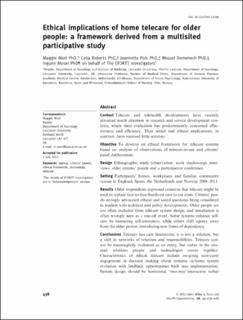| dc.description.abstract | Context
Telecare and telehealth developments have recently attracted much attention in research and service development contexts, where their evaluation has predominantly concerned effectiveness and efficiency. Their social and ethical implications, in contrast, have received little scrutiny.
Objective
To develop an ethical framework for telecare systems based on analysis of observations of telecare‐in‐use and citizens’ panel deliberations.
Design
Ethnographic study (observation, work shadowing), interviews, older citizens’ panels and a participative conference.
Setting
Participants’ homes, workplaces and familiar community venues in England, Spain, the Netherlands and Norway 2008–2011.
Results
Older respondents expressed concerns that telecare might be used to replace face‐to‐face/hands‐on care to cut costs. Citizens’ panels strongly advocated ethical and social questions being considered in tandem with technical and policy developments. Older people are too often excluded from telecare system design, and installation is often wrongly seen as a one‐off event. Some systems enhance self‐care by increasing self‐awareness, while others shift agency away from the older person, introducing new forms of dependency.
Conclusions
Telecare has care limitations; it is not a solution, but a shift in networks of relations and responsibilities. Telecare cannot be meaningfully evaluated as an entity, but rather in the situated relations people and technologies create together. Characteristics of ethical telecare include on‐going user/carer engagement in decision making about systems: in‐home system evolution with feedback opportunities built into implementation. System design should be horizontal, ‘two‐way’/interactive rather than vertical or ‘one‐way’. An ethical framework for telecare has been developed from these conclusions (Table 1). | en_US |
